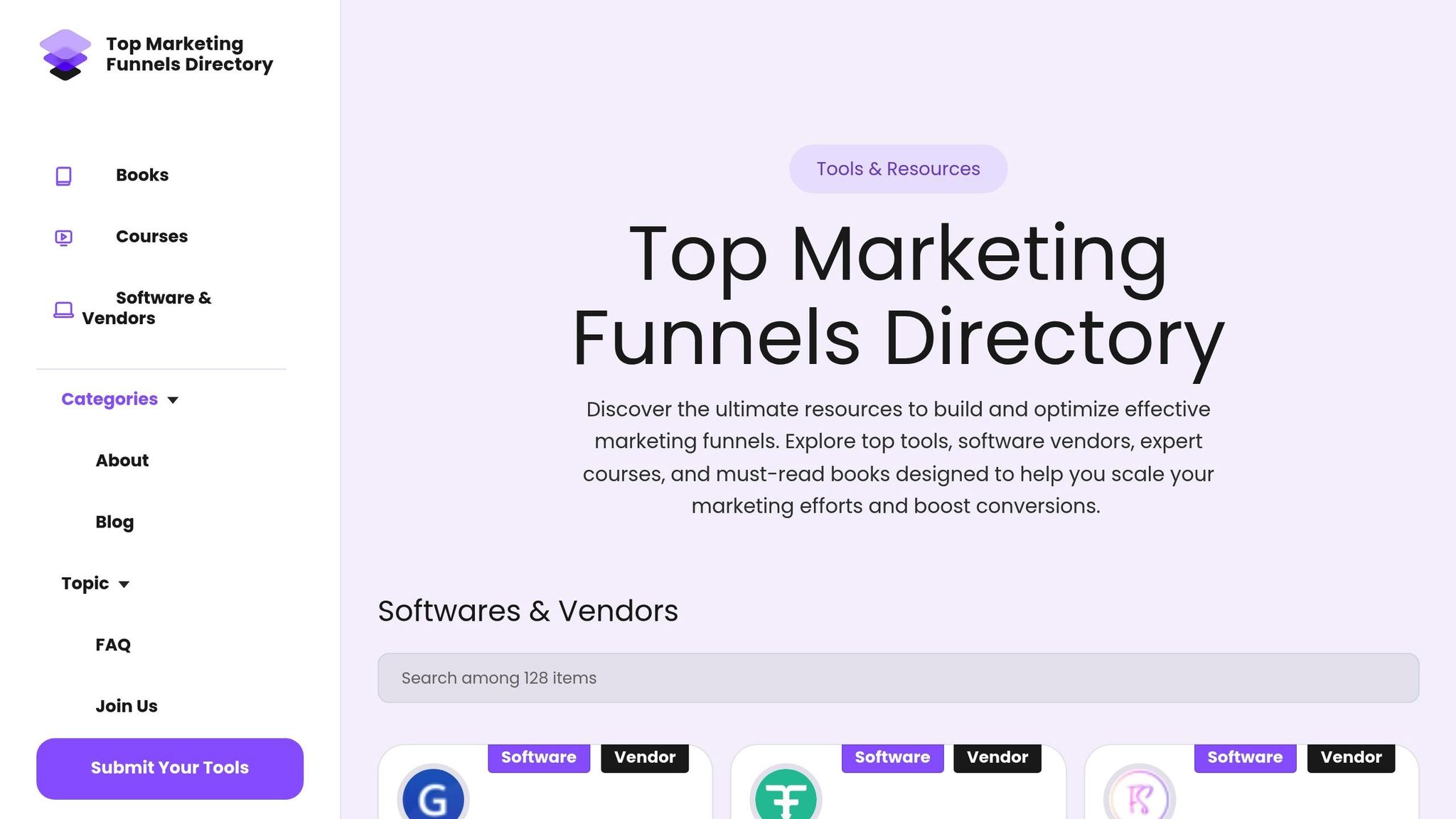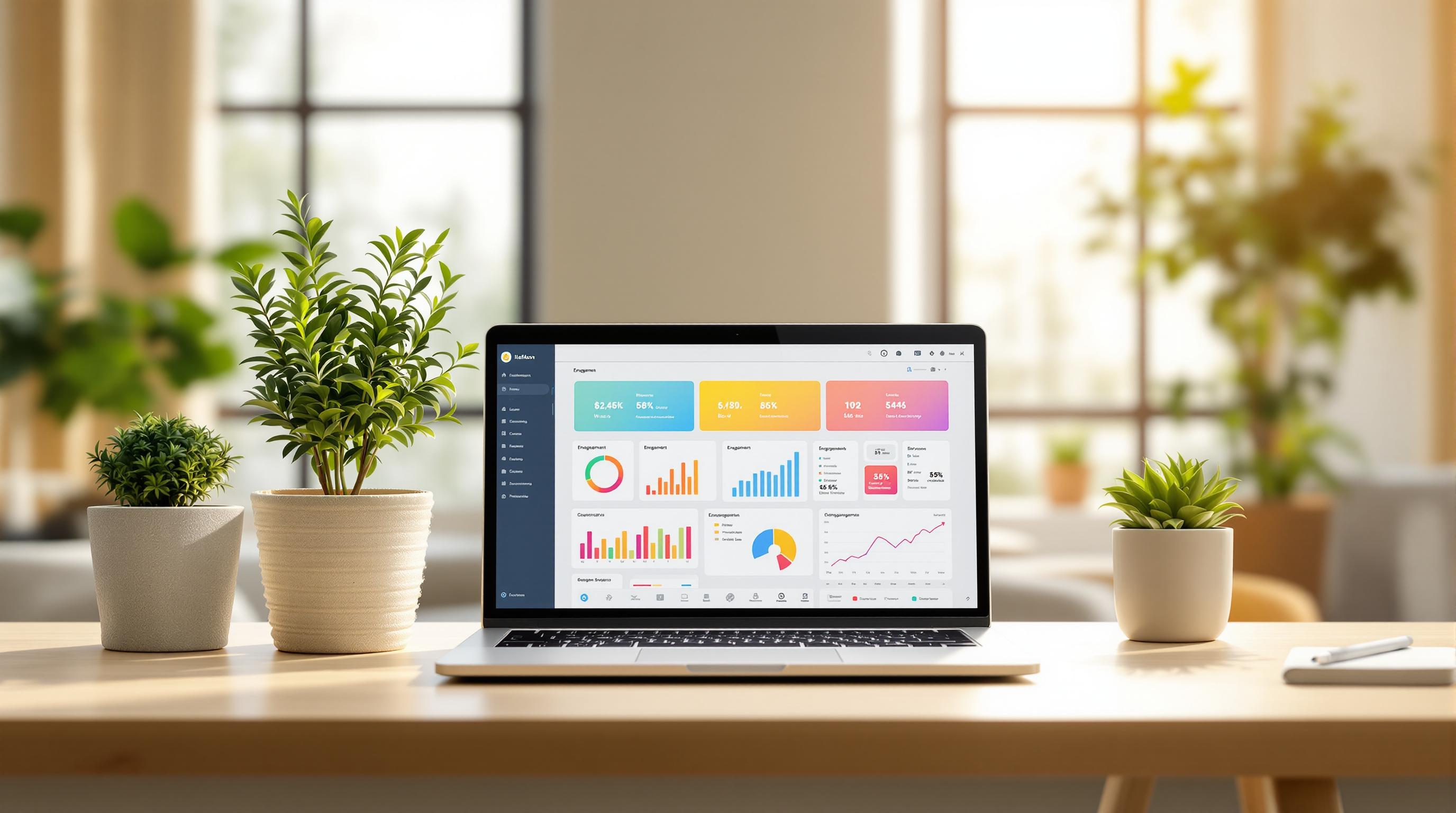Funnel dashboards track customer journeys and help businesses improve conversions. With mobile usage on the rise, optimizing these dashboards for smaller screens is essential. Here's a quick guide to building mobile-friendly dashboards:
- Choose the Right Tools: Look for platforms like Microsoft Power BI that support mobile layouts, auto-formatting, and interactive testing.
- Design for Mobile: Place key metrics at the top, use vertical layouts, and simplify navigation for touchscreens.
- Visualization Tips: Use scorecards, progress bars, and vertical bar charts. Avoid clutter and keep text readable.
- Test Across Devices: Ensure dashboards work on various devices and browsers. Optimize for speed and usability.
For additional resources, explore the Marketing Funnels Directory for tools, courses, and vendor listings.
Key takeaway: A well-designed mobile dashboard gives you quick, clear insights anytime, anywhere.
How To Create Power BI Dashboards For Mobile: Day And Night Modes 2024 - P2 | NextGen BI Guru
Choosing Tools for Mobile Dashboard Creation
Picking the right tool for creating your mobile-friendly funnel dashboard is crucial. It lays the groundwork for smooth performance and ensures your dashboard is optimized for mobile use.
Key Features to Look for in Tools
When evaluating tools, prioritize those that come with dedicated mobile layout views and interactive phone emulators. These features let you design and test dashboards in real time, mimicking the user experience on mobile devices. Tools with an auto-create mobile layout option are especially useful, as they can instantly generate mobile-optimized reports.
A well-designed formatting pane is another must-have. It allows you to tweak visual elements, resize charts, and adjust text sizes, ensuring your dashboard looks sharp on smaller screens. Additionally, tools that support interactive testing and automatic orientation detection help you avoid costly revisions. Look for visual indicators that confirm whether your design is mobile-ready.
Recommended Dashboard Tools
Among the available options, Microsoft Power BI stands out for its mobile optimization features. Back in April 2025, Power BI showcased its advanced capabilities, including dedicated mobile layout views and automatic report generation. Reports created with Power BI are automatically formatted to display in portrait orientation within its mobile apps for iOS and Android. Special icons in the app indicate when a report is mobile-optimized, making it easier to identify at a glance.
When choosing a tool, think about how it integrates with your current marketing technology stack. Resources like the Marketing Funnels Directory (https://topmarketingfunnels.com) can help you explore dashboard tools and funnel-building platforms that work seamlessly together, creating a unified mobile marketing experience.
It’s worth noting that mobile-optimized dashboard views are usually accessible through dedicated mobile apps. Web browsers, on the other hand, often display the standard desktop versions, which may not provide the same level of usability on smaller screens.
Layout and Navigation Best Practices
Designing a mobile-friendly funnel dashboard means tailoring it for small screens while ensuring it remains functional and easy to navigate. Beyond leveraging tool features, the layout and navigation should prioritize efficiency for mobile users.
Responsive Layout Design Principles
Start by placing key metrics at the top-left - this aligns with natural reading patterns. Use a hierarchical structure, positioning high-level metrics at the top and supporting details below. For example, display the overall conversion rate prominently at the top, followed by metrics for individual funnel stages. Clearly define each stage of the funnel to reflect the customer journey accurately.
To dig deeper into data, include drill-down features for detailed insights. Group Key Performance Indicators (KPIs) into logical categories - like separating paid, organic, and email data - so comparisons remain clear and users don’t mix traffic sources when analyzing performance. Consistent spacing and a clear visual hierarchy further enhance the organization of these groupings. Once the metrics are well-structured, intuitive navigation is the final piece to ensure a seamless mobile experience.
Mobile Navigation Patterns
Keep navigation simple by using bullet points or concise text for clarity. Use colors intentionally: green for positive signals, orange for warnings, and red for alerts. Avoid assigning colors randomly; instead, highlight top-performing metrics with a single standout color while keeping the rest in neutral tones. Stick to low-saturated hues to minimize distractions from branding elements and ensure data remains the focus.
Make sure visuals render smoothly on mobile devices. Remove unnecessary grid lines and clutter to keep the data front and center. Fonts, colors, and icons should serve a clear purpose - avoid using them for decoration alone. Finally, fast load speeds and fully responsive pages are critical. Users expect quick access to their funnel data, and delays can lead to frustration or abandonment.
Data Visualization Techniques for Mobile
Creating effective data visualizations for mobile devices requires a different approach than designing for desktops. With smaller screens, every element must be carefully chosen to maintain clarity and usability. These techniques focus on making data easy to understand and accessible, even on compact displays.
Mobile-Friendly Visualization Types
Once you've established a layout and navigation that works well on mobile, the next step is designing visualizations that make the most of the limited space. Here are some options that work particularly well:
- Scorecards: These are perfect for showcasing a single key metric, like conversion rates, total leads, or revenue. They use minimal space while still delivering high impact, with clear labels that make the data stand out.
- Simple tables: Use tables sparingly and keep them simple - three columns at most. Alternating row colors can improve readability, but avoid tables that require horizontal scrolling. If the data is too complex, consider splitting it into multiple views to keep things manageable.
- Vertical bar charts: These align naturally with the scrolling behavior users expect on mobile. For example, when displaying funnel performance, vertical charts let users quickly scan from top to bottom without needing to rotate their device or struggle with horizontal layouts.
- Progress bars: These are an excellent choice for showing goal completion or progress. They're easy to understand at a glance and don’t rely on axes or legends. A simple progress bar labeled "68% to monthly goal" communicates far more effectively on a small screen than a cluttered multi-series chart.
Some visualization types, however, don’t translate well to mobile. Avoid pie charts with more than three segments, complex line charts with multiple data series, and scatter plots, as they often become confusing or unreadable on smaller screens.
Avoiding Clutter and Improving Readability
Designing for mobile isn’t just about choosing the right charts - it’s also about creating a clean and user-friendly interface. Here’s how to keep your visualizations clear and readable:
- Use white space strategically: Don’t feel the need to fill every inch of the screen. White space helps users focus on individual elements, guiding their attention and preventing the design from feeling overwhelming.
- Prioritize high contrast: Ensure text and chart elements stand out against their backgrounds. This is especially important for mobile users viewing dashboards in bright sunlight or dim conditions. Avoid subtle color differences that might be hard to distinguish on certain screens.
- Choose readable font sizes: Stick to at least 14px for body text and 18px for key metrics. Remember, users might be checking your dashboard on the go, so larger text improves both accessibility and usability.
- Keep labels short and clear: Replace lengthy descriptions with concise alternatives. For instance, instead of "Total Number of Qualified Leads Generated This Month", simply use "Qualified Leads", with the time frame indicated elsewhere in the layout.
- Focus on one metric at a time: Instead of cramming multiple KPIs into a single view, dedicate each section of the screen to one clear metric. Users can swipe or tap to see additional details, which also helps maintain consistent spacing and visual hierarchy.
- Use progressive disclosure: Show summary metrics upfront and make detailed data available through taps or swipes. This keeps the interface clean for casual users while still providing depth for those who need it.
sbb-itb-a84ebc4
Testing and Optimization Strategies
Creating a mobile-friendly funnel dashboard is only the beginning; making sure it performs well across various devices is where the real work begins. By following layout and navigation best practices, testing ensures that your designs function smoothly in mobile environments. With over 65% of internet traffic coming from mobile devices, testing isn’t just a good idea - it’s a must to guarantee your dashboard adds value for users, no matter where they are.
Device Testing and User Feedback
Testing on actual devices is key. While browser simulators are great for quick checks, they often miss subtle issues that arise on real iOS and Android phones, tablets, or smaller laptops. Physical device testing can reveal problems like touch responsiveness, scrolling glitches, or unexpected performance slowdowns.
Start with browser developer tools like Chrome DevTools or Firefox Responsive Design Mode for initial checks. Then, expand your testing with platforms like BrowserStack, Responsinator, or Screenfly to cover a wider range of screen sizes and devices.
Don’t overlook cross-browser compatibility. A dashboard that looks flawless in one browser might have layout problems in another. During testing, pay close attention to how content scales - there should be no need for horizontal scrolling. Ensure navigation menus (like hamburger menus) work smoothly, text remains readable without zooming, and multimedia elements like images and videos resize correctly. Forms should be easy to fill out, and no elements should overlap or get cut off. Considering that 40% of users will abandon a site after a poor mobile experience, these details are critical.
Once your dashboard works well across devices and browsers, shift your focus to optimizing its performance for mobile users.
Performance Optimization for Mobile Dashboards
Speed is everything for mobile users, especially those on slower networks or older devices. To keep users engaged, your funnel dashboard must load quickly and respond instantly to interactions.
Simulate slower networks, such as 3G or 4G, using network throttling tools in Chrome’s developer tools. This helps you gauge how your dashboard performs under real-world conditions.
Make performance monitoring a habit. Set up automated tests to track load times, responsiveness, and overall functionality across various devices and network conditions. Automated visual regression testing can also identify layout problems across different screen sizes, reducing the need for time-consuming manual checks.
The ultimate goal is to create a dashboard that feels built for mobile, not just a scaled-down version of a desktop experience. When users can easily access their funnel data, make quick decisions, and navigate effortlessly, you’ve hit the sweet spot of functionality and performance.
Using the Marketing Funnels Directory

Discover a wealth of reliable tools and resources with the Marketing Funnels Directory. Just like responsive design is essential for mobile dashboards, staying updated with current vendor resources ensures your tools remain effective and adaptable.
Finding Tools and Resources
The directory simplifies the process of finding high-quality, vetted resources for building successful marketing funnels. Each vendor listing includes detailed information about software features, such as responsive design and compatibility across devices, so you can make well-informed decisions.
In addition to tools, the directory provides access to valuable learning materials. You'll find courses on mastering sales funnels and book recommendations that cover key strategies. These resources offer practical frameworks and methodologies that can be applied to your mobile dashboard projects, helping you refine your approach and achieve better results.
Staying Updated with Best Practices
Choosing the right tools is just the beginning - keeping up with updates and best practices is equally important. The Marketing Funnels Directory is regularly refreshed to include the latest tools and resources, ensuring you're always equipped to handle changes in devices, screen sizes, and user behaviors. It highlights new vendors and tools while tailoring its offerings to various funnel types, such as social media, ads, content, and B2B strategies.
Conclusion
Creating mobile-friendly funnel dashboards starts with picking tools that genuinely work across all screen sizes. Look for platforms that prioritize mobile optimization while preserving both data accuracy and visual clarity.
Once you've chosen the right tools, focus on designing layouts that put users first. Responsive design is the key to making effective mobile dashboards. Think vertical layouts, touch-friendly navigation, and generous spacing to ensure an intuitive experience. Mobile users need quick, easily digestible insights, so simplicity is your best friend here.
When it comes to data visualization for mobile devices, a less-is-more approach works wonders. Use straightforward charts, clean typography, and thoughtful color choices to help users instantly grasp key funnel metrics. Keep it clutter-free by sticking to the essentials - this makes decision-making on the go much smoother.
After nailing the design and layout, testing is a must. Try your dashboard on different devices, gather feedback, and fine-tune it based on real-world usage. Performance optimization is especially important since users will access dashboards under varying network conditions and on diverse devices. Regular testing helps you spot and fix any performance hiccups.
For ongoing insights and resources, check out the Marketing Funnels Directory. Staying informed about tools and best practices ensures your dashboards evolve alongside advancements in mobile technology, keeping you ahead in a competitive landscape.
Ultimately, a well-designed mobile funnel dashboard empowers users to make smart, informed decisions - anytime, anywhere. By applying these strategies and leveraging quality resources, you can deliver mobile experiences that truly drive business results.
FAQs
What features should you prioritize when selecting tools for creating mobile-friendly funnel dashboards?
When selecting tools to create mobile-friendly funnel dashboards, it's crucial to focus on responsiveness and performance optimization. These features are key for ensuring quick load times and smooth interactions, even on smaller screens. Additionally, tools that offer customizable visualizations and a straightforward, user-friendly interface are important for presenting data clearly and making navigation effortless.
By prioritizing these elements, you can create dashboards that are not only practical but also enjoyable to use on mobile devices.
How do I make sure my mobile dashboard is easy to read and use on any device?
Creating a mobile dashboard that works well across all devices starts with focusing on responsive design principles. Opt for grid-based layouts that automatically adjust to different screen sizes, and arrange elements vertically on smaller screens to keep things clear and organized. It’s also important to design for both portrait and landscape orientations to improve usability.
Use flexible containers and scalable elements so the dashboard can adapt to varying resolutions without losing its functionality. Avoid cramming too much into the interface - prioritize the most important information and choose fonts that are easy to read. By following these steps, your dashboard can stay practical and user-friendly, no matter the device.
What are the best ways to design mobile-friendly dashboards that are clear and easy to use?
Designing Mobile-Friendly Dashboards
Creating mobile-friendly dashboards that are easy to navigate starts with keeping the layout clean and straightforward. Stick to a minimal number of views and colors to prevent overwhelming users. Instead of using legends, label chart elements directly so users can quickly grasp the information without extra effort.
For a seamless mobile experience, focus on touch-friendly controls and use font sizes that are easy to read on smaller screens. Position critical elements, like filters or labels, above the charts to ensure they stay visible during interactions. By simplifying layouts and highlighting the most important data, your dashboards will be more accessible and easier to use on mobile devices.


